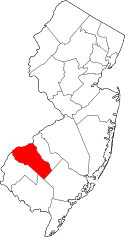Red Bank Battlefield
|
Red Bank Battlefield | |
|
Fort Mercer Monument | |
   | |
| Location | 100 Hessian Avenue, National Park, New Jersey |
|---|---|
| Coordinates | 39°52′13″N 75°11′25″W / 39.87028°N 75.19028°WCoordinates: 39°52′13″N 75°11′25″W / 39.87028°N 75.19028°W |
| Area | 20 acres (8.1 ha) |
| Built | 1748 |
| Architectural style | Georgian |
| NRHP Reference # | 72000796[1] |
| NJRHP # | 1405[2] |
| Significant dates | |
| Added to NRHP | October 31, 1972[1] |
| Designated NHL | November 28, 1972[3] |
| Designated NJRHP | August 16, 1979 |
The Red Bank Battlefield is located along the Delaware River in National Park, Gloucester County, New Jersey, United States. It was the location of the Battle of Red Bank in the American Revolutionary War on October 22, 1777. Fort Mercer and its sister, Fort Mifflin in Pennsylvania, defended the river and prevented the British from using it for transportation. The forts successfully delayed the British, but in the end, they were both destroyed or abandoned.
Today the site of the Battle of Red Bank is a part of the Gloucester County Parks system called Red Bank Battlefield Park.
James and Ann Whitall House
The central feature of the park is the James and Ann Whitall House.[4][5] This structure, a brick and stone house just outside the works of Fort Mercer, served as a hospital for some of the men wounded in the fighting. The house suffered damage during the battle. Ann Cooper Whitall had remained in the house during the fighting and tended to the wounded, earning her the epithet "Heroine of Red Bank."
Park features
Although much of the battlefield has eroded into the Delaware River, some portions of Fort Mercer (named after Brigadier General Hugh Mercer, killed at the Battle of Princeton on January 3, 1777.[6]) remain. The prominent historical feature of the park is the remains of the ditch which surrounded the now-gone earthworks. Around these works and along the riverbank are several period cannons, including four raised from the wreck of the British man-of-war, HMS Augusta, and a British sloop, Merlin. The three American cannons facing the Whitall House were found in 1935 buried on the site. Nearer to the Whitall House, a preserved section of the chevaux-de-frise river defenses of the Fort Mercer and Fort Mifflin system is displayed, along with various cannonballs recovered from the battlefield. Several monuments honor the combatants, including a memorial to the fallen Hessian leader, whose remains were buried on the grounds, and a 75-foot (23 m)-tall monument.
Visiting
The 44-acre (180,000 m2) park is open to visitors during daylight hours. The Whitall House may be visited during more limited hours. An annual reenactment of the battle takes place on the park grounds in October. In the early 1980s, a lifeguard was on duty and swimming was permitted in the Delaware River.
See also
References
- 1 2 National Park Service (2010-07-09). "National Register Information System". National Register of Historic Places. National Park Service.
- ↑ "New Jersey and National Registers of Historic Places - Gloucester County" (PDF). New Jersey Department of Environmental Protection - Historic Preservation Office. April 1, 2010. p. 6. Retrieved September 28, 2010.
- ↑ "Red Bank Battlefield". National Historic Landmark summary listing. National Park Service. 2008-06-23.
- ↑ Snell, Charles W. (May 12, 1972). "Red Bank Battlefield and Fort Mercer" (pdf). National Register of Historic Places - Nomination and Inventory. National Park Service. Retrieved 25 May 2012.
- ↑ "Red Bank Battlefield and Fort Mercer" (pdf). Photographs. National Park Service. Retrieved 25 May 2012.
- ↑ Genealogical history of Battle of Red Bank

